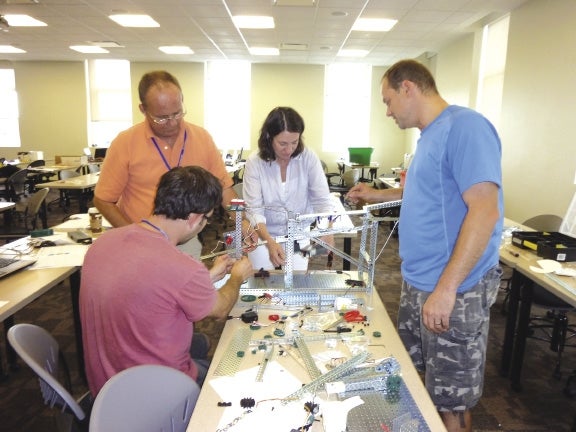School-Business Bond Blossoms From STEM Outreach
 PHOTO/Courtesy
High school teachers build a marble sorting machine as part of an engineering principles curriculum at Worcester Polytechnic Institute. It's one of several programs WPI offers that help teachers improve their skills in teaching STEM-related subjects.
PHOTO/Courtesy
High school teachers build a marble sorting machine as part of an engineering principles curriculum at Worcester Polytechnic Institute. It's one of several programs WPI offers that help teachers improve their skills in teaching STEM-related subjects.
Careers in science, technology, engineering and mathematics — also known as the STEM fields — are some of the fastest growing, not only nationally, but statewide.
And various organizations say there's a shortage of STEM-skilled workers to fill jobs. An economic outlook report released last spring by the New England Economic Partnership and The New England Council pointed toward a shift in demand for "STEM and other high-skill, high-knowledge occupations" as one of the biggest long-term challenges for Massachusetts. That challenge has been on the radar of state officials and educators for more than a decade, and they, along with business leaders, are collaborating to come up with ways to get kids interested in STEM from a young age.
In 2003, the Department of Higher Education began to administer the STEM Pipeline Fund to increase the number of students who participate in programs that support careers in STEM fields, boost the ranks of STEM teachers and improve related educational offerings. That was followed in 2010 with a STEM plan that outlined goals the Patrick administration saw as most important for the state, along with the creation of a STEM advisory council.
Sandra Mayrand, director of the STEM Pipeline Network of Central Massachusetts and the University of Massachusetts Medical School's Regional Science Resource Center, said government involvement has helped those who are trying to foster STEM interest.
"Now that the state government is really involved, they've given us a direction so that we can all be working toward the same goals, and that makes a huge difference in how resources are deployed," she said.
Mayrand said the network's 50 members include people involved in early childhood development, along with business and nonprofit leaders and advocacy groups.
"The idea is to have a common conversation and then action in the region," she said.
A key to the network's success has been business involvement, whereas, until the 1990s, the dialogue was taking place only in academia, and educators did not have a good understanding of businesses' needs. That's changed now, Mayrand said, as educators and business leaders have conversations that help them understand each other's perspectives — and those conversations lead to collaboration.
One example is Intel, EMC, Abbott Laboratories and the University of Massachusetts Medical School joining for Innovation Month each March, when scientists from those organizations visit seventh-grade classrooms in Worcester to get students to participate in hands-on activities.
Mayrand said those classroom visits are "huge" in piquing students' interest in STEM fields. She said when the kids are asked what jobs there are at the medical school, they say nurse, doctor and pharmacist. "They don't know that there are so many other science, engineering (and) technology jobs at a medical school," she said. "It's our job to make it more visible as to what the jobs are."
The awareness of jobs in STEM fields goes hand-in-hand with helping students see the relevance of what they learn in science and math classes.
Deborah Kochevar, dean of Tufts University's Cummings School of Veterinary Medicine in Grafton, said her school has a "special privilege" to help foster students' curiosity because kids often already have an interest in animals.
She said it's easy to talk about a child's dog, explain what it eats, what's in their food and why it's important, and then equate that with STEM subjects.
"There's so many ways to use pets as a good starting point for a discussion of STEM," Kochevar said.
Taking the real-world practice a step further, Cummings recently opened a pet clinic at Worcester Technical High School. It allows low-income pet owners to get treatment for their animals while veterinary students gain more primary care experience. Meanwhile, high school students in the vet tech program assist and see how the science and math they learn can be applied.
With similar goals, Worcester Polytechnic Institute (WPI) is also a force for growing interest. Martha Cyr, executive director of WPI's STEM Education Center, said the school offers a range of programs for fourth graders, from half-day sessions about math applications to two-week residential programs in which students become immersed in a specific topic like robotics or aerospace engineering. This summer, WPI hosted 720 students for STEM programs. She said the school has been doing STEM outreach for about 20 years and recently launched the center.
"It was set up to help teachers and education leaders be able to bring the best STEM content to their students possible in ways that will engage the students," Cyr said.
She and other leaders say professional development is a key to increasing STEM interest.
Kochevar said professional development is even more valuable than student programs because "you get a bigger bang for your buck. The better educated and the better experiences all kids have in schools, the better it's going to be," she said.
The programs' success is hard to gauge, but part of the STEM Advisory Council's plan is to determine interest through a questionnaire when students register to take the SAT college admissions test. The council's goal is to increase interest in STEM college majors to 35 percent by 2016, up from the Patrick administration's estimate of 25 percent in 2009.
"The goal for all of these (programs) is to interest kids in STEM careers and make sure they're prepared for it," Mayrand said, "because it's going to be our economic success as a state that's going to depend on this."
(Editor's note: An earlier version of this story incorrectly identified one of the STEM subjects.)
Read more
Startup Will Commercialize WPI Technology
Carving Out A Niche In Regenerative Medicine
Growing Cells And Innovation: WPI Launches Biofabrication Graduate Program













0 Comments